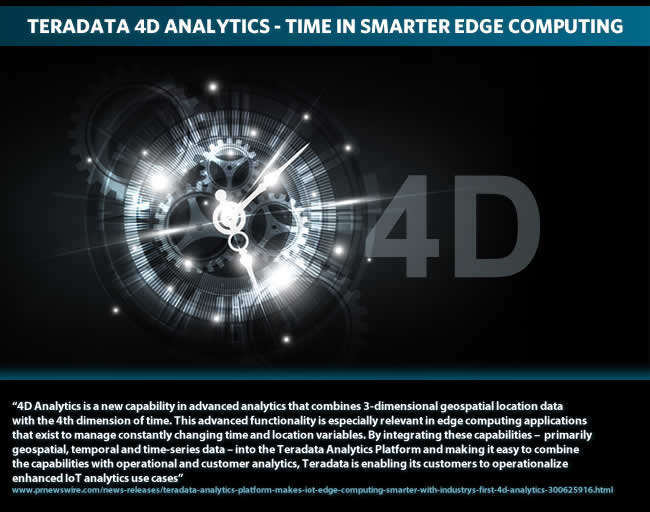Cloud-based business analytics and data solutions provider Teradata has added a new 4D Analytics ‘advanced analytics’ capability to its Analytics Platform for edge computing.
4D Analytics enables to combine existing three-dimensional geospatial location data and temporal data possibilities with time-series data (hence the ‘4D’) for edge computing IoT use cases with stronger predictive capabilities.
The 4D Analytics capability fits in the context of smarter Industry 4.0, Industrial IoT edge applications and other edge computing use cases where time and location variables (by definition) constantly change. Time series data and functions are added to existing temporal capability and 3D geospatial (latitude, longitude, and elevation) data. When combining “the where” of geospatial insights to “the when” (a mix of the time series data and temporal data) new insights and use cases are the result.

Smarter predictive capabilities, contextual analytics and root-cause analysis
One key element of 4D Analytics is that IoT-scale time-series data enable (better) root-cause analysis (the when and where), taking us beyond predictive maintenance in the sense of not just being able to say something is about to happen but also why this is the case.
In other words: more advanced predictive capabilities and more contextual analytics. Smarter IoT edge computing is mentioned explicitly in the announcement and on the landing page of the new Teradata 4D Analytics capability where use cases in the scope of transportation, logistics and fleet management, smart(er) cities, smarter cars and infrastructure, and smarter wearable devices are also mentioned and explained. More advanced analytics and 4D insights clearly means smarter than smart.

The combination of several of the mentioned capabilities which are integrated in the Teradata Analytics platform enable more applications, whereby the use case defines the needed data and analytics.
Examples include pro-active patient treatment, swarm intelligence, better traffic throughput and reduced energy consumption in the scope of ‘smart traffic’ and driver availability as Teradata’s Rob Armstrong explains. Smart cities is one of the key areas for 4D Analytics. At the occasion of the launch Teradata reminded its collaboration with Cisco (announced in March 2018) on a digital transformation solution with a focus on smart cities and communities, combining smart city IoT platform Cisco Kinetic for Cities and the Teradata Analytics Platform.
In a blog post at the occasion of the launch of the added 4D Analytics capabilities Rob Armstrong dives deeper into these mentioned IoT (edge) use cases to explain the essence of the addition of the dimension of time with clear examples of the greater predictive capabilities and contextual analytics.
He does so across several scenarios whereby the addition of layers of analytics effectively enables different use cases and thus goals in a tangible way. He moves from planning delivery routes in transportation and logistics (fleet effectiveness), mobility-as-a-service (adding temporal data to the fleet management example) and urban planning in smart cities to edge computing.
Although the 4D analytics capability is mainly about IoT and edge computing with the aim to operationalize enhanced IoT analytics use cases, integration with operational and customer analytics capabilities in the Teradata platform the company emphasizes.
4D Analytics at the edge and the role of time series data: the Production Analytic Platform

Teradata further offers a report which you can download on the Teradata website from Dr. Barry Devlin of 9Sight, who according to the Teradata 4D Analytics announcement conducted research, resulting in a paper end 2017 on a Production Analytic Platform, citing time series data as the basis for advanced analytics of the output of the Internet of Things.
This Production Analytic Platform is what the report is about. The paper discusses “how the Production Analytic Platform marries predictive analytics to production values and goals whereby handling the complexities of analyzing time dependent data, especially from the Internet of Things, is central”.
On his website Dr. Barry Devlin published a PDF, containing four of his “ThoughtPoints” published from October 2017 to January 2018 covering various aspects of the Production Analytic Platform.
The announcement from Teradata on its 4D Analytics states that “an advanced functionality combining 3-dimensional geospatial location data with the 4th dimension of time is especially relevant in edge computing applications that exist to manage constantly changing time and location variables”.
Tim Henry, Senior VP, Strategic Offering Management at Teradata on the new 4D Analytics capabilities in the press release: “We are on the brink of a massive explosion of IoT applications and use cases powered by advanced analytics. Devices at the edge, like connected cars, fleets, planes, traffic lights, roads, wearables and so much more, will become smarter and more valuable as new analytic insight is pushed out to them.”
More in the press release where you can also find more links and examples of how the 4D Analytics capability can improve various applications, “with new logic and rules making the edge smarter”.
Top image: Shutterstock – Copyright: CKA – All other images are the property of their respective mentioned owners

